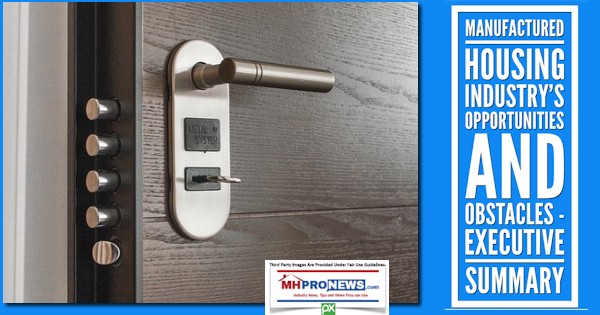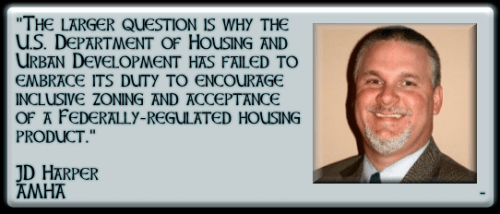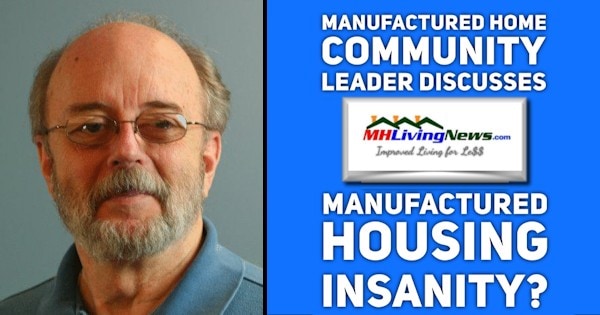
The headline should be understood as a pull quote from what follows below. It is also an example of biting sarcasm from the keyboard of Mark Weiss, J.D., President and CEO of the Manufactured Housing Association for Regulatory Reform (MHARR).
Some pull quotes from what follows from Wiess at MHARR will help frame a serious problem.
- On May 15, 2019, MHARR invited state manufactured housing associations around the country to provide it with particularly egregious, actionable cases of zoning and/or placement discrimination by localities against federally-regulated manufactured homes.
- (1) to stem the tide of baseless restrictions on the placement of manufactured homes (absent a more aggressive assertion of broad federal preemption by HUD, which MHARR has been seeking for years);
- and (2) to expand the availability of modern, affordable manufactured homes in accordance with the Manufactured Housing Improvement Act of 2000 [MHIA].
One might presume that such an initiative would be met with open arms by state associations, who were directly contacted and asked to provide examples of such problems in their state.
Let’s note that this MHARR initiative occurred months prior to the July letter from the Manufactured Housing Institute (MHI) addressed to HUD Secretary Ben Carson that called for full implementation of the MHIA, including the enhanced preemption provision of that landmark MHIA legislation.
Under Pressure, MHI Pivots “HUD Must Implement and Enforce its Enhanced Preemption Authority”
MHARR notes that one cause for this issue is, in Weiss’ words:
- As an aside, it’s worth noting that lying at the root of the industry’s major post-production problems relating to exclusionary and/or discriminatory zoning and placement restrictions, and the discriminatory treatment of manufactured housing consumer personal property loans – despite the existence of good laws addressing the implementation of both – is the absence of a truly independent, national, collective, post-production trade organization.
Quite so, a point that MHProNews, MHLivingNews, and others in manufactured housing have made directly and/or indirectly.
Let’s see the specifics of what Weiss said, and the conclude with some additional observations by MHProNews.

MHARR — ISSUES AND PERSPECTIVES
By Mark Weiss
SEPTEMBER 2019
“THE INCREDIBLE SHRINKING ZONING PROBLEM”
Well, the good news is that the debilitating zoning problem faced by the HUD Code manufactured housing industry and its consumers has apparently evaporated into thin air. That’s right. On May 15, 2019, MHARR invited state manufactured housing associations around the country to provide it with particularly egregious, actionable cases of zoning and/or placement discrimination by localities against federally-regulated manufactured homes. MHARR sought information on cases involving the discriminatory exclusion of both manufactured home communities and individual home placements (one each, from each state) that could be vetted and, if necessary, litigated – by MHARR, or with MHARR support, as appropriate – to seek and obtain favorable precedents that could then be asserted in other jurisdictions: (1) to stem the tide of baseless restrictions on the placement of manufactured homes (absent a more aggressive assertion of broad federal preemption by HUD, which MHARR has been seeking for years); and (2) to expand the availability of modern, affordable manufactured homes in accordance with the Manufactured Housing Improvement Act of 2000. Given the reports that seem to emerge almost daily concerning local jurisdictions imposing outright or partial bans on the placement of manufactured homes, combined with the nearly year-long downturn in manufactured housing sales volume, one would have expected a robust response to this offer of no-strings assistance and support. Instead, the response – for the most part — has been silence.
As an aside, it’s worth noting that lying at the root of the industry’s major post-production problems relating to exclusionary and/or discriminatory zoning and placement restrictions, and the discriminatory treatment of manufactured housing consumer personal property loans – despite the existence of good laws addressing the implementation of both – is the absence of a truly independent, national, collective, post-production trade organization. As MHARR has previously emphasized, it is the absence of such an organization, focused on effectively addressing specific and quite serious problems affecting the post-production sector – for the ultimate benefit of the entire industry and manufactured housing consumers – which has allowed those problems to fester and grow steadily worse.
So, why the cricket-chorus this time? The zoning problem has certainly not gone away. Far from it. If anything, it continues to get worse, with the city of Bryan, Texas being one of the latest jurisdictions to effectively ban new HUD Code manufactured housing placements, while it toys with a program to offer buy-outs to owners of manufactured homes already sited within its borders and thereby shrink the presence of manufactured homes in that jurisdiction altogether. Even the Manufactured Housing Institute (MHI) has acknowledged that exclusionary and unduly restrictive zoning ordinances are a major – and growing – problem for the industry and manufactured homebuyers, stating on its website: “There is a growing trend of municipalities trying to use zoning and other land use regulations to restrict or eliminate manufactured housing in their jurisdictions.” (Emphasis added). Simply put, everyone in, or even remotely connected with, the HUD Code manufactured housing industry – including and especially state associations which are the closest to these issues — knows that discriminatory zoning-based exclusions and restrictions on the placement of manufactured homes represent a major obstacle to the use and availability of today’s federally-regulated HUD Code homes in direct contravention and violation of federal law. Consequently, awareness of the problem, at least within the industry and its representative organizations, is not lacking.
What has been lacking – for too long – is an aggressive strategy and effective, consistent follow-through in confronting, addressing and, ultimately, reversing this post-production (by definition) phenomenon that brazenly discriminates against lower and moderate-income manufactured housing consumers, negatively impacts the entire HUD Code industry by effectively closing-off huge swaths of the country, including major population centers, to the placement of inherently affordable, modern HUD Code manufactured homes, and harms society at large by increasing homelessness and the societal costs associated with the failure to meet basic housing needs.
To be sure, there has been no lack or absence of talk on this subject from the organization that touts itself as the national representative of “all segments” of the industry. According to a March 29, 2019 MHI “News & Updates” publication, zoning “is a standing agenda item for MHI’s Federated States Division.” In a “recap” of MHI’s work “with state associations … to fight the problem of exclusionary zoning,” the document recounts a string of conferences, meetings, memoranda, proposals, comment letters and the like (primarily with HUD) dating back to 2015. This apparently resulted in MHI being “invited by HUD to attend [a] … listening session” on proposed modifications to the Affirmatively Furthering Fair Housing (AFFH) regime initially put forward by the Obama Administration. In addition, according to the same document, “MHI has become regular exhibitors (sic) at the National League of Cities and the National Association of Counties” which, presumably, is good for MHI. What the report lacks, however – likely because it does not exist – is evidence of a national program of aggressive, organized, persistent and focused action designed to prevent, overturn and ultimately invalidate exclusionary and discriminatory local zoning actions directed against federally-regulated manufactured homes. The report, therefore, is little more than confirmation of the “Illusion of Motion” thesis addressed in the January 2019 MHARR Issues and Perspectives column entitled “The Illusion of Motion Versus Real World Challenges.”
Ironically, just prior to MHI’s missive regarding zoning, the MHARR Board of Directors, at its March 27, 2019 Annual Meeting, determined that given: (1) the highly-negative impact of exclusionary and discriminatory zoning measures in suppressing the overall manufactured housing market; (2) the failure of the industry’s post-production sector and that sector’s erstwhile national representative to effectively challenge such actions in an organized and consistent manner; and (3) the public recognition (and related pronouncements) by HUD Secretary Ben Carson regarding the devastating impact of exclusionary zoning on the availability of affordable housing in many areas of the country — the time had come to mount such a targeted and consistent legal effort, in conjunction and cooperation with state associations, to challenge and seek to overturn one or more particularly egregious such zoning measures. In adopting this strategy and program, the Board decided to follow a dual-track approach to zoning, with one track focused on potential private litigation (and related preparatory activity) targeting exclusionary zoning, and a second track focused on prompting HUD to address the negative impacts of exclusionary zoning within the specific context of the manufactured housing market.
In an April 2, 2019 report on its just-concluded Board meeting, MHARR described the state-based part of this dual-track approach as follows:
“Discriminatory zoning – zoning restrictions or exclusions targeted at manufactured housing and manufactured housing consumers over large areas of the United States and the failure of the broader industry to effectively fight and address those mandates – is a crucial aspect of the industry’s inability to expand and better serve the housing and homeownership needs of large numbers of Americans. To begin addressing this issue with the urgency that it deserves and warrants, MHARR will work cooperatively with state-level industry associations to target a sample set of localities with major and/or obvious discriminatory prohibitions against HUD Code manufactured homes and, following appropriate fact-finding, will mount an aggressive campaign against those prohibitions, including litigation, if necessary, to the highest level that may be needed.”
From the start, therefore, this effort was visualized and planned as a joint undertaking between MHARR and the various state associations – which, again, are closest to the problem – to target and address specific cases of egregious local-level restrictions against the placement of both individual manufactured homes and manufactured home communities.
Several weeks later, on May 15, 2019, MHARR formally launched its “Fighting Discriminatory Zoning Mandates” project by sending questionnaires to state manufactured housing associations seeking specific information for “review, study analysis and follow-up,” concerning “the two most egregious instances of exclusionary and/or discriminatory zoning within their respective states, with one involving the development or expansion of [an existing] manufactured housing community and the other involving the placement of an individual home on private land.” (Emphasis added).
In the interim, in an April 4, 2019 meeting with officials from HUD’s Office of Policy Development and Research (PD&R) and in April 24, 2019 correspondence to HUD Secretary Ben Carson, to launch the parallel HUD track of its zoning project, MHARR called on HUD to initiate and conduct nationwide research, and follow-up analysis, “concerning local zoning mandates that discriminatorily exclude or drastically restrict the placement of federally-regulated manufactured homes to the detriment of lower and moderate-income American families in large areas of the country,” as a prelude to specific, concrete steps by HUD to end the discrimination inherent in those restrictions. MHARR thus concluded: “Given the destructive impact of such discriminatory and exclusionary local mandates on the availability of affordable, non-subsidized housing and homeownership, in direct conflict with Trump Administration policies designed to increase homeownership among Americans at every rung of the economic ladder, we ask that HUD join with MHARR in this effort to end such baseless discrimination and the virtual exclusion of safe, decent and affordable HUD-regulated manufactured homes from entire areas of the United States….” (Emphasis in original). MHARR continues to press this matter with HUD and Secretary Carson, as the Trump Administration has since launched a working group to specifically address the availability of affordable housing, including the negative impacts of exclusionary zoning.
Predictably, though, surrogates and apologists for the ineffective status quo, immediately and publicly attacked this effort, with one ostensible post-production “leader,” who has done little more than organize meetings and seminars, and publish books (for a fee, of course), stating: “So where do we go from here? Nowhere!” MHI, meanwhile, was apparently concerned enough to publish the above-described missive on its ostensible actions over the last several years to address such restrictions. Whether there was other behind-the-scenes pressure brought to bear on the various state associations by the promoters of the status quo is a matter of conjecture, but the bottom-line result is not. Of the thirty-something state manufactured housing associations contacted by MHARR with regard to this project, responses – of any type – were received from only six. Of these, only one (thank you!) responded with completed forms providing the information that MHARR had requested. Two others apparently handed-off MHARR’s inquiry to private parties that are presumably members of those associations – this despite MHARR’s specific request that responses be provided officially through the collective industry representation in that state (i.e., the state associations). Still others responded with what can best be characterized as historical material, but nothing regarding current restrictions or exclusions that could be ripe for adjudication. Finally, one was more forthcoming about actions it might pursue on its own account (which MHARR will leave to that group to address as it sees fit).
Thus, despite MHARR’s offer of support and assistance concerning an issue of acknowledged national state and local-level importance, the vast majority of manufactured housing state associations did not respond at all, let alone respond with information that would have been useful in addressing and resolving the problem of exclusionary zoning.
Given MHARR’s long-term track record of effective advocacy and accomplishments on behalf of the industry, whether it be enactment of the Manufactured Housing Improvement Act of 2000, enactment of the Duty to Serve Underserved Markets (DTS) as part of the Housing and Economic Recovery Act of 2008 (HERA), action in the wake of President Trump’s election to change the leadership of the HUD manufactured housing program, its opposition to – and reversal of – the disastrous 2016 proposed U.S. Department of Energy manufactured housing energy rule, or a myriad of other actions, and again, in light of the horrific impact that exclusionary zoning has had and is having on the availability and utilization of manufactured homes, one would have thought that all of these organizations would have taken the opportunity to target, investigate and address particularly egregious cases of zoning exclusion within their respective states with MHARR’s assistance and support. Their general lack of response, however – far from indicating that the problem with exclusionary zoning is going or has gone away – is instead indicative of a dysfunctional national-level post-production representation which both directly and indirectly demands unswerving allegiance without corresponding positive results. The result has been a long-term erosion in market-presence and market size with a corresponding consolidation of production within the industry – all to the detriment of American consumers of affordable housing and smaller industry businesses.
Like it or not, the, the issue of exclusionary and discriminatory zoning will not go away and cannot be wished away. It undermines and

erodes the entire national manufactured housing market – a market that should never be, or become dependent upon, emergency housing orders by government agencies. As the most-affordable homeownership resource in the nation, manufactured housing must have equitable access to all areas of all jurisdictions where single-family homes may be sited. It is therefore necessary to break down the barriers that already exist and seemingly grow worse every day, not only for the sake of the industry and those who earn their living within the industry, but for the sake of every American who wants to own a home but is effectively forced out of the market because they would be barred from placing a manufactured home where they wish to live. Viewed this way, exclusionary zoning is not only a de facto tax that needlessly robs people of their money and resources, but also robs them of their freedom to live, work and raise their families where they wish, not to where some local official – elected or otherwise – happens to think they (and their home) should be relegated. Combatting this exclusionary trend will not be easy, but it is a challenge that the industry must meet and must win. It will not be possible to “win,” though, without putting up a fight to start with.
Mark Weiss
MHARR is a Washington, D.C.-based national trade association representing the views and interests of independent producers of federally-regulated manufactured housing.
##
This is indeed an example of the “Illusion of Motion.”
But it may be more sinister than that, as Weiss himself suggests. Quoting:
- “Whether there was other behind-the-scenes pressure brought to bear on the various state associations by the promoters of the status quo is a matter of conjecture, but the bottom-line result is not.”
MHProNews has previously reported on strong arm tactics purportedly used by Berkshire brands on state associations. Those allegations came directly from state association executives.

MHProNews reported more recently what Cavco Industries’ Manny Santana, speaking on behalf of MHI, publicly voting against a position at the Manufactured Housing Consensus Committee (MHCC) what MHI claimed to be supporting.
As MHProNews reported yesterday, prior to seeing this report and commentary from Weiss, that MHI’s fine new video actually raised questions that undercut their own claims.
First-time readers and serious researchers that need a 40,000 foot level overview of such concerns should see the executive summary linked below, plus the related report following the byline and notices, additional insights on this issue.

The net result of this status quo is consolidation within the industry, but logically significant harm to potentially millions of current manufactured homeowners, prospective buyers, taxpayers, and thousands of independents working in the industry.

That’s your troubling but revealing final installment today for accountability and growth-focused manufactured home “Industry News, Tips, and Views Pros Can Use” © where “We Provide, You Decide.” © ## (News, analysis, and commentary.)

Soheyla is a managing member of LifeStyle Factory Homes, LLC, the parent company to MHProNews, and MHLivingNews.com. Connect with us on LinkedIn here and and here.
Related Reports:
Click the image/text box below to access relevant, related information.



























